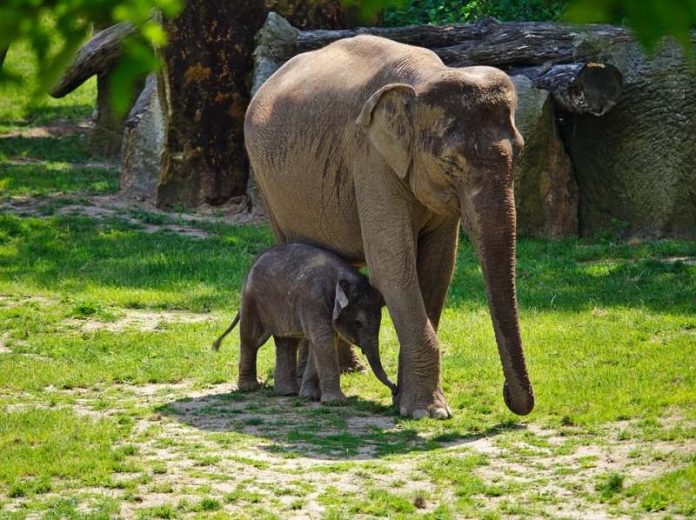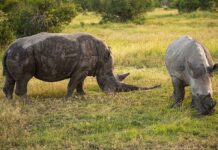
Researchers have unpacked data from compensation records of human-wildlife conflicts in Kerala, to throw light on the hotspots of human-elephant conflicts in the south Indian state that has one of the highest density of Asian elephants (Elephas maximus) in the country.
Asmita Sengupta of Ashoka Trust for Research in Ecology and the Environment said compensation records of human-wildlife conflicts could be leveraged to capture a snapshot of the distribution of human-wildlife conflicts across landscapes and help in prioritisation of areas that need immediate intervention.
Sengupta and colleagues constructed a human-elephant conflict (HEC) index based on analysis of compensation data for 17,216 compensation cases registered with the Kerala Forest Department for the years 2009 to 2015 for all the 14 districts of the state, although there were no records of compensation for Alappuzha. Of the cases, the animals were specified for 16,312 records.
“Elephants accounted for 48 percent of the 16,312 records and elephant-related compensation records accounted for 43.2 percent of the total number of cases across the years on an average. We identified Wayanad, Kannur, and Palakkad as the districts having high HEC,” Sengupta told Mongabay-India, referring to the analysis published in the journal Human Ecology.
“By expediting the prioritisation of the districts, this approach will help mitigate HEC even outside the protected areas,” she said.
In India, 80 percent of elephant distribution is outside protected areas (PAs) and human-elephant conflicts (HEC) are common. The southern population is the largest and represents 48 percent of the total population of 29964 elephants in the country. The state of Karnataka harbours 6049 elephants, the largest population of elephants in the country. At 5706 elephants, Kerala in the Western Ghats has the third-largest elephant population in the country as per the 2017 census.
The study finds that districts with high HEC were also the ones in which the highest number of compensation claims against wildlife damage had been registered. Higher conflict was reflected both in the number of cases that were registered against elephants in these districts as well as the amount of compensation paid for elephant damages. Elephants were also among the top three wildlife species causing damage in all the districts except one, the analysis revealed.
Compensation was paid for 16,948 cases and amounted to Rs 217,756,915 for the study period. The mean amount paid per year was Rs 31,108,131. Compensation paid for damage caused by elephants accounted for 13 percent of the total. Crop damage accounted for 84 percent of these cases and 67 percent of the compensation amount. Human death accounted for 2.2 percent of these cases and 20 percent of the compensation amount.
With the appraisal method suggested in the paper, identifying the districts which need immediate intervention would be faster. “Conducting consultations with various stakeholders in those districts would be the next step. It would then need to be followed up with data collection on relevant ecological parameters and focus group discussions and interviews with people who have incurred damage caused by elephants or share space/resources with elephants within those districts,” Sengupta explained.
Sandeep Kumar Tiwari, program manager of the IUCN SSC Asian Elephant Specialist Group, who was not associated with the study, said when compensation data is combined for several forest divisions it also offers landscape-level insights into the challenge.
“The compensation data is basically records of crop depredation/human injury or death for each forest division and when many of these forest division data is combined, it provides information at the landscape level,” Tiwari, who was earlier deputy director and head, Wild Lands, Wildlife Trust of India (2002-2016), told Mongabay-India.
A landscape approach to conservation and reduction in human-wildlife conflict is emphasised in India’s National Wildlife Action Plan (2017-2031).
“When you pool this data from multiple years and map the distribution of these compensations, it provides you valuable information including where the conflicts happening and which clusters reported maximum damage (help identify conflict hotspots), animals and group size, crop types damaged, seasonality of damage, mitigation measures used in those areas (and the success of those measures) and other information,” Tiwari said.
Refreshing human-elephant conflict mitigation measures in accordance with priority areas
According to Sengupta, in Kerala, crop foraging was found to be the most frequent cause of damage. In the districts with high HEC, crop-foraging by elephants accounted for 57–71 percent of the total number of cases documented. The researchers underscore Palakkad, Kannur, and Wayanad districts in Kerala should be prioritised in the reformulation of HEC mitigation measures and that these should be targeted towards curbing crop-foraging by elephants.
Although HEC can be driven by various factors such as elephant density, human density, natural resource availability, and extent of forest cover, the analysis did not reveal any significant links between these factors and the conflicts. “More information about the cropping patterns, seasonal rainfall patterns, locations of water bodies, elephant demography, and behaviour, and crop-guarding methods across the state may help understand the trends better,” added Sengupta.
For example, the researchers found no relationship between the number of cases reported against elephants and rainfall in Kerala, which is in contrast to the observations around the Nagarhole National Park in the neighbouring state of Karnataka where compensation data revealed that conflict frequencies were highest during August–November, a period when there was a decrease in rainfall and important crops such as finger millet, maize, and paddy were ripening. This finding is similar to that of Chen et al. (2016) in China, where they reported that HEC became more intense during the rainy season when crops such as paddy, corn, beans, peanuts, and sugarcane matured.

Sanjay Gubbi, scientist at Nature Conservation Foundation who has studied HEC around Nagarhole National Park based on compensation data filed with the wildlife department of Karnataka, said despite its shortcomings, parsing through compensation data is perhaps “one of the best methods to get long-term data over vast spatial scales (protected area district, or state).”
“Compensation is principally disbursed by the state governments. Compensation claims can help understand spatio-temporal patterns of human-wildlife conflict (including human-elephant conflict). This, in turn, is very helpful to understand high, medium and low conflict areas that can feed into developing conflict mitigation strategies. Some times, from these compensation records, we are unable to pinpoint the species of conflict other than elephants, or large carnivores,” Gubbi told Mongabay-India.
Sengupta highlights that their calculations for Kerala may be underestimates because many compensation records did not specify the identity of the wildlife species.
In addition to compensation schemes of the state governments, financial and technical assistance is provided to elephant range states under ‘Project Elephant’, to protect elephants, their habitat and corridors, to address issues of man-elephant conflict and the welfare of captive elephants. The scheme has also a component for ex-gratia relief in case of human death/injury and property/crop loss, according to the Ministry of Environment, Forest and Climate Change (MoEFCC). In 2018, the MoEFCC raised the compensation for death and permanent incapacitation to humans caused by wild animals to Rs 5 lakh from up from Rs 2 lakh earlier.
As many as 2361 people were killed in incidents of conflict with elephants between 2014-15 and 2018-19. In that same period, as many as 510 elephants were killed in incidents of electrocution, train accidents, poaching, and poisoning. The Indian government holds that human deaths due to negative interactions between humans and elephants have declined from 2016-17 to 2018-19. The compensation paid by the government for human deaths from conflicts with elephants from 2016-2017 to 2018-2019 was 48.14 crores (480 million).
Plugging gaps in compensation claims
According to the government’s Elephant Task Force, 2010 report, more than half of the expense incurred by Project Elephant under the 10th Five Year Plan (2002-2007) was for HEC mitigation. Another 15 to 20 percent was spent on ex-gratia and compensation for loss of property or crops. More than two of every three rupees spent on elephant conservation directly or indirectly deals with HEC.
To shore up compensation filing and manage losses incurred by communities several chinks in the chain need to be filled in.
Many farmers do not even file claims because the compensation (or ex-gratia as it is called) paid does not match the market value of the crop/livestock/infrastructure loss and the transaction cost incurred to avail of this ex-gratia is quite high, explained Gubbi.
“Besides, the documentation process is prolonged and the long delay in getting the compensation also discourages many people from applying for the claims. Also, there are misconceptions amongst the field staff of the forest department that compensation can be provided when the loss occurs due to certain species,” Gubbi said.
For instance, in many areas, people are discouraged from filing compensation claims when the damages are from bonnet macaques or wild pigs. Gubbi believes that compensation has to be provided when any wild animal as per the definition under the Wildlife Protection Act 1972 causes the damage.”
Tiwari bemoaned the lack of uniform methods used to measure crop damage due to elephants and it depends on the evaluators. In some places, they take what is reported, in some cases, they do visual estimation and in others, they measure the length and breadth of the damaged area and calculate the area. “Often people over-report as they are aware, the area will be reduced by evaluators. In encroached areas, people are not compensated for crop loss, hence villagers don’t report. There is also favouritism and at times over-reporting,” Tiwari told Mongabay-India.
“But in spite of all these, the records are an excellent source of information to map conflict and formulate management strategies,” added Tiwari.
To plug the gaps, the losses have to be matched closely to the market value, payment has to be timely, and importantly, people affected by human-wildlife conflict need a sympathetic ear to pour out their problems. “Hence, outreach is an important tool not just during the time of conflict but should be implemented as a proactive measure,” said Gubbi.
Karnataka Forest Department has tried to digitise conflict complaint filing and the other processes involved with the government documentation. “It has also put compensation claims under the Karnataka Sakala Services Act 2011 (which is a bill to provide a guarantee of services to citizens within the stipulated time limit) both of which are novel. We hope that it will be implemented on-ground with the same spirit,” said Gubbi.
Harish Vasudevan, an expert in environmental law, underscored that the compensation disbursed is paltry and a one-size-fits-all approach doesn’t work.
“The amount should change from person to person. What is the financial position of the person at the time of death, what is the actual damage to the family; sometimes one is the only earning member in the family. So that must be treated differently. There should be a minimum amount and it needs to be upgraded depending on the specific case,” Vasudevan told Mongabay-India.
Importantly, Vasudevan adds that proper measures should be implemented to prevent wildlife from entering non-forest areas. “They say railway fencing can be done but due to lack of money, they are not doing it. Solar fencing is not effective for elephants. The headache of fencing rests with the forest department. We should rethink developmental projects to include conservation projects so that the lack of budgetary allocation can be overcome.”

CITATION
Sengupta, A., Binoy, V. V., & Radhakrishna, S. (2020). Human-Elephant Conflict in Kerala, India: a Rapid Appraisal Using Compensation Records. Human Ecology, 1-9.
This article was originally published in The Mongabay.












